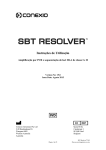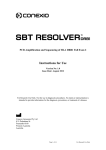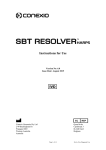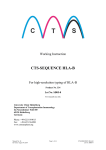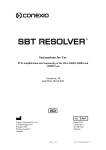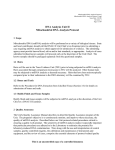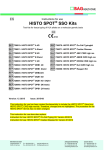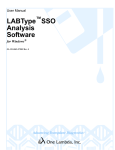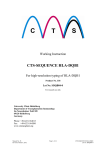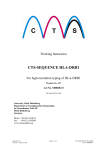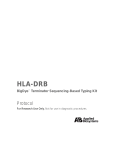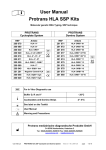Download Instructions for Use
Transcript
Instructions for Use PCR Amplification and Sequencing of HLA Class I and II Loci Version No: 15.0 Issue Date: August 2015 EC Conexio Genomics Pty Ltd 2/49 Buckingham Dr Wangara 6065 Western Australia Australia REP Qarad bvba Cipalstraat 3 B-2440 Geel Belgium Page 1 of 25 For In-Vitro Diagnostic Use Contents PRINCIPLE ..............................................................................................................................3 INTENDED USE ......................................................................................................................3 KIT COMPOSITION ..............................................................................................................4 STORAGE REQUIREMENTS ...............................................................................................9 MATERIALS, REAGENTS AND EQUIPMENT NOT SUPPLIED ..................................9 SAMPLE REQUIREMENTS................................................................................................10 WARNINGS AND SAFETY PRECAUTIONS ...................................................................11 SYMBOLS ..............................................................................................................................11 PROCEDURE .........................................................................................................................12 1. 2. 3. 4. 5. 6. 7. PCR .......................................................................................................................................... 12 AGAROSE GEL ELECTROPHORESIS ............................................................................................ 12 PURIFICATION OF PCR PRODUCT .............................................................................................. 13 SEQUENCING REACTION ........................................................................................................... 14 PURIFICATION OF SEQUENCING REACTION PRODUCTS.............................................................. 15 DENATURATION & ELECTROPHORESIS OF SEQUENCING REACTION PRODUCTS ........................ 16 EDITING AND ANALYSIS OF ELECTROPHEROGRAMS .................................................................. 17 PERFORMANCE CHARACTERISTICS ...........................................................................18 ACCURACY ......................................................................................................................................... 18 DETECTION LIMIT ............................................................................................................................... 19 SPECIFICITY ........................................................................................................................................ 19 LIMITATIONS AND CAUTIONS .......................................................................................19 LICENSE ................................................................................................................................20 BIBLIOGRAPHY...................................................................................................................20 TROUBLESHOOTING .........................................................................................................21 RELATED PRODUCTS ........................................................................................................24 SUPPORT AND CONTACT DETAILS ..............................................................................25 Page 2 of 25 For In-Vitro Diagnostic Use Principle The HLA Sequencing Based Typing (SBT) procedure described here was originally developed by D. Sayer in 20011 and developed into a single tube assay in 20042. The procedure involves the initial amplification of the target sequence followed by enzymatic treatment to remove unincorporated primers and dNTPs. The amplicon is then used as a template for direct automated fluorescent DNA sequencing using customized sequencing primers and the Big Dye® Terminator sequencing chemistry available from Applied Biosystems™ by Life Technologies™. The extension products are purified according to the ethanol precipitation method and denatured using Hi-Di™ formamide available from Applied Biosystems™ by Life Technologies™, before separation and detection on an automated fluorescent DNA sequencer. It is recommended that the resulting data is then analysed with Assign™ SBT sequence analysis software from Conexio Genomics Pty Ltd3-5. Intended Use Conexio Genomics’ SBT Resolver™ HLA SBT kits are used for the typing of HLA Class I (HLA-A, -B, and -C) and Class II (HLA-DRB1, -DQB1 and -DPB1) genes in a laboratory setting from genomic DNA. Each kit contains reagents that facilitate the PCR amplification and DNA sequencing of a given gene. The resultant sequencing data is then interpreted through the use of Conexio Genomics’ Assign™ SBT software. It should be noted that these SBT kits are not used for the diagnosis of disease. Page 3 of 25 For In-Vitro Diagnostic Use Kit Composition Kit PRE-PCR Contents† (No of vials) Catalogue No POST-PCR Contents (No of vials) Class I HLA-A XH-PD1.1-2(20) XH-PD1.1-2(50) HLA-B BS-PD2.1-2(20) 20 tests 50 tests 20 tests DNA POL – HLA-A 1 x 25L AEX1F AEX1R HLA-A MIX 1 x 352L AEX2F AEX2R AEX3F AEX3R AEX4F AEX4R DNA POL – HLA-A 1 x 60L AEX1F AEX1R HLA-A MIX 1 x 880L AEX2F AEX2R AEX3F AEX3R AEX4F AEX4R BEX1F BEX2F BEX2R BEX3F BEX3R BEX4F DNA POL – HLA-B 1 x 25L HLA-B MIX 1 x 352L 1 x 44L each 1 x 110L each 1 x 44L each BEX4R BS-PD2.1-2(50) 50 tests DNA POL – HLA-B 1 x 60L HLA-B MIX 1 x 880L BEX1F BEX2F BEX2R BEX3F BEX3R BEX4F 1 x 110L each BEX4R Page 4 of 25 For In-Vitro Diagnostic Use Kit Catalogue No HLA-C HH-PD 3.2-2(20) PRE-PCR Contents† (No of vials) 20 tests POST-PCR Contents (No of vials) DNA POL – HLA-C 1 x 25L CEX1F CEX1R HLA-C MIX 1 x 352L CEX2F CEX2R CEX3F CEX3R CEX4F CEX4R CEX5F CEX5R CEX6F CEX6R 1 x 44L each CEX7F HH-PD 3.2-2(50) 50 tests DNA POL – HLA-C 1 x 60L CEX1F CEX1R HLA-C MIX 1 x 880L CEX2F CEX2R CEX3F CEX3R CEX4F CEX4R CEX5F CEX5R CEX6F CEX6R 1 x 110L each CEX7F Class II HLA-DRB1 HH-PD5.2-5(20) 20 tests DNA POL – DRB1 1 x 10L DRB1EX2F HLA-DRB1 MIX 1 x 370L DRB1EX3R-2 Page 5 of 25 DRB1EX2R-2 RB-TG344-R 1 x 44L each For In-Vitro Diagnostic Use Kit PRE-PCR Contents† (No of vials) Catalogue No HH-PD5.2-5(50) LG-PD5.2-7(20) 50 tests 20 tests POST-PCR Contents (No of vials) DNA POL – DRB1 1 x 20L DRB1EX2F DRB1EX2R-2 HLA-DRB1 MIX 1 x 920L DRB1EX3R-2 DNA POL – DRB1 1 x 10L DRB1EX2F DRB1EX2R-2 HLA-DRB1 MIX 1 x 370L DRB1EX3F-7 DRB1EX3R-7 RB-TG344-R 1 x 110L each 1 x 44L each RB-TG344-R LG-PD5.2-7(50) 50 tests DNA POL – DRB1 1 x 20L DRB1EX2F DRB1EX2R-2 HLA-DRB1 MIX 1 x 920L DRB1EX3F-7 DRB1EX3R-7 1 x 110L each RB-TG344-R HLA-DQB1 PQ-PD6.2-2(20) PQ-PD6.2-2(50) AN-PD6.2-3(20) 20 tests 50 tests 20 tests DNA POL – DQB1 1 x 10L DQB1EX2F DQB1EX2R HLA-DQB1 MIX 1 x 370L DQB1EX3F DQB1EX3R DNA POL – DQB1 1 x 20L DQB1EX2F DQB1EX2R HLA-DQB1 MIX 1 x 920L DQB1EX3F DQB1EX3R DNA POL – DQB1 1 x 10L DQB1EX2F DQB1EX2R-3 HLA-DQB1 MIX 1 x 370L DQB1EX3F DQB1EX3R Page 6 of 25 1 x 44L each 1 x 110L each 1 x 44L each For In-Vitro Diagnostic Use Kit AN-PD6.2-3(50) HLA-DPB1 PRE-PCR Contents† (No of vials) Catalogue No HH-PD10.1(20) HH-PD10.1(50) KD-PD10.2-1(20) 50 tests 20 tests 50 tests 20 tests POST-PCR Contents (No of vials) DNA POL – DQB1 1 x 20L DQB1EX2F DQB1EX2R-3 HLA-DQB1 MIX 1 x 920L DQB1EX3F DQB1EX3R DNA POL – DPB1 1 x 10L DPB1EX2F DPB1EX2R HLA-DPB1 MIX 1 x 370L 1 x 44L each DNA POL – DPB1 1 x 20L DPB1EX2F DPB1EX2R HLA-DPB1 MIX 1 x 920L 1 x 110L each DNA POL – DPB1 1 x 10L DPB1EX1F DPB1EX1R HLA-DPB1 MIX 1 x 370L DPB1EX2F DPB1EX2R DPB1EX3F DPB1EX3R DPB1EX4F DPB1EX4R DPB1EX5F DPB1EX5R 1 x 110L each 1 x 44L each PB-AG341-R Page 7 of 25 For In-Vitro Diagnostic Use Kit PRE-PCR Contents† (No of vials) Catalogue No KD-PD10.2-1(50) 50 tests POST-PCR Contents (No of vials) DNA POL – DPB1 1 x 20L DPB1EX1F DPB1EX1R HLA-DPB1 MIX 1 x 920L DPB1EX2F DPB1EX2R DPB1EX3F DPB1EX3R DPB1EX4F DPB1EX4R DPB1EX5F DPB1EX5R 1 x 110L each PB-AG341-R † The PRE-PCR kit contains a vial of a locus-specific PCR mix (e.g. primers, along with a single vial of DNA polymerase (e.g. The POST-PCR kit contains sequencing primers (e.g. HLA-A MIX DNA POL – HLA-A AEX1F ) consisting of PCR buffer, dNTPs, MgCl2, and locus specific PCR ). ). Page 8 of 25 For In-Vitro Diagnostic Use Storage Requirements The PRE- and POST-PCR boxes may be separated and stored in designated PRE- and POSTPCR freezers. When stored at -20C (temperature range of -15C to -25C is acceptable), the kit components can be used until the expiry indicated on the outer kit containers and can tolerate up to 25 freeze-thaw cycles. Accelerated stability testing for the HLA-A, -B, -C, -DRB1, -DQB1 and -DPB1 kits indicated a shelf life of two and a half years from date of manufacture when stored at -20°C. While confirmatory real-time testing is underway it is strongly recommended that these kits are NOT to be used beyond their expiry date. To maintain optimal kit performance, the kit components should be removed from the -20C storage location and thawed rapidly at room temperature before use. The kit components, with the exception of the polymerase, should then be gently vortexed to ensure that the components of each tube are appropriately mixed after thawing. After use, the kits/components should be returned immediately to -20C. Materials, Reagents and Equipment Not Supplied PCR 1. Sterile water 2. Electronic or mechanical pipettes and aerosol-resistant tips 3. Thermal cycler with heated lid These kits have been validated using the following thermal cyclers: MJ Research PTC 225 DNA Engine DYAD™, Applied Biosystems™ by Life Technologies™ Veriti™ Thermal cycler, Gene Amp® PCR System 9700, and Eppendorf Mastercycler® Pro. Use of other thermal cyclers with these kits requires validation by the user. 4. 0.2mL thin-walled thermal cycling reaction tubes (8 well strips or 96 well plates). Use those recommended for use with your thermal cycler. 5. Sterile 1.5mL tubes 6. Sterile work area such as biological safety cabinet or hood. 7. Table top centrifuge with plate adapters and capacity to reach 2500 x g 8. Vortex Agarose Gel Electrophoresis 9. Agarose gel electrophoresis apparatus 10. 1% agarose (molecular biology grade) TBE gel containing 0.1g/mL ethidium bromide. 11. Loading buffer 12. PCR Marker suitable to cover range of 300 – 1300 bp 13. UV transilluminator Purification of PCR Product 14. ExoSAP (USB® ExoSAP-IT® Cat No 78200 for 100 reactions or Illustra™ ExoProStar™ Cat No US77702 for 100 reactions) Page 9 of 25 For In-Vitro Diagnostic Use 15. 2mM MgCl2 (Available for purchase from Conexio Genomics, product code MgCl21.0(50) or MgCl2-1.0(3000)) 16. Shaker The use of alternative PCR purification techniques requires validation by the user prior to use. Sequencing Reaction 17. BigDye® Terminator Cycle Sequencing Kit v3.1 or v1.1, Applied Biosystems™ by Life Technologies™. 18. 5x Sequencing Reaction Buffer (Conexio Genomics, product code SEQ BUF2.0(400) or SEQ BUF-2.0(5000)) or BigDye® Terminator v3.1 or v1.1 5X Sequencing Buffer, Applied Biosystems™ by Life Technologies™. Purification of Sequencing Reaction Products 19. 125mM EDTA, pH8.0 (Available for purchase from Conexio Genomics, product code EDTA-3.0(200) or EDTA-3.0(5000)). 20. Absolute and 80% Ethanol. Each run requires freshly prepared 80% ethanol consisting of absolute ethanol and sterile water. DO NOT USE DENATURED ETHANOL (also known as methylated spirits in some countries). The use of alternative sequencing purification techniques requires validation by the user prior to use. Denaturation and Electrophoresis of Sequencing Reaction Products 21. Hi-Di™ Formamide, Applied Biosystems™ by Life Technologies™, product code 4311320 22. Automated DNA Sequencer and accessories (e.g. Applied Biosystems™ by Life Technologies™ ABI Prism® 3730), including data collection and software. These kits have been tested and validated on the Applied Biosystems™ by Life Technologies™ 3100, 3730 and 3730xl capillary sequencers and software. The use of other denaturation techniques and sequencing platforms requires validation by the user prior to use. 23. HLA Sequencing Analysis Software (e.g. Assign™ SBT, version 3.6+ or higher Conexio Genomics Pty Ltd). Sample Requirements 1. Sterile water (negative/ no template control) 2. High molecular weight human genomic DNA (concentration range of 20-100ng/µL in Tris/EDTA buffer and OD260/280> 1.8) extracted from ACD or EDTA anticoagulated whole blood specimens. Do NOT use whole blood specimens containing heparin. Page 10 of 25 For In-Vitro Diagnostic Use Warnings and Safety Precautions This kit must be used by trained and authorized laboratory personnel. All samples, equipment and reagents must be handled in accordance with good laboratory practice. In particular, all patient material should be considered as potentially infectious. The use of gloves and laboratory coats is strongly recommended. Handle and dispose of all sample material according to local and national regulatory guidelines. There are NO dangerous substances contained in any of the kit components. Do NOT use reagents beyond their expiration date. The use of kit components from different kit batches is NOT recommended. Such use may affect the assay’s performance. Use of reagents not included in this kit or not listed under “Materials, Reagents and Equipment Not Supplied” (e.g. alternative Taq DNA polymerases) is NOT recommended. Such use may affect the performance of the assay. Care should be taken to prevent cross-contamination of DNA specimens. Change tips between DNA specimens wherever possible. Pre- and Post-PCR activities must be strictly physically separated. Use specifically designated equipment, reagents and laboratory coats. Ethidium bromide is a potential carcinogen. Protective gloves must always be used when preparing and handling gels. Dispose of ethidium-bromide gels and buffers according to local and national guidelines. While viewing and photographing agarose gels under UV light, always avoid direct exposure and use appropriate UV-blocking face protection, disposable gloves and laboratory coats. Symbols The following non-standard symbols have been used: Symbol Description HLA-X MIX Locus specific PCR Mix DNA POL – XXXX AEX1F DNA polymerase HLA-A exon 1 forward sequencing primer. Refer to “Kit Composition” and Table 4 for other sequencing primers. Date of manufacture (required for non-EU markets). Page 11 of 25 For In-Vitro Diagnostic Use Procedure 1. PCR 1.1. A separate PCR reaction will need to be set up for each locus to be amplified, and for each individual sample to be tested. Each run should include appropriate positive control/s of known genotype, and at least one negative control for each locus being amplified. 1.2. Prepare a fresh solution of PCR master mix each time a PCR is performed. Quickly thaw the locus-specific PCR mix at room temperature. Once thawed, vortex briefly. 1.3. Dispense the required volume of PCR mix and DNA polymerase into a sterile tube for the number of samples to be tested (refer to Table 1 below for the volume per reaction). Pulse vortex the solution 3-4 times. Locus A B C DRB1 DQB1 DPB1 Locus-specific PCR Mix 16L 16L 16L 16.7L 16.7L 16.7L e.g. HLA-A MIX DNA Polymerase 1L 1L 1L 0.3L 0.3L 0.3L e.g. DNA POL – HLA-A Table 1: Composition of the master mix required per sample. 1.4. Dispense 17L of the master mix into each reaction well. 1.5. Add 3L of sample DNA or appropriate positive control/s to each reaction well. Add 3L of sterile water to the negative control reaction well. 1.6. Seal the reaction wells. Mix gently by vortexing and centrifuge briefly. 1.7. Place the reaction wells into a thermal cycler and run according to the thermal cycling conditions below. 95°C - 10 mins 96°C - 20 secs 60°C - 30 secs 72°C - 3 mins 33 cycles 15°C - hold 1.8. Amplification takes approximately 2.5 hours to complete. 1.9. When the PCR is completed, remove the reaction wells/plate from the thermal cycler and either proceed directly to gel electrophoresis or store at 4°C until required. NOTE: Purification of amplicons by ExoSAP treatment should occur within 24 hours of completion of PCR. 2. Agarose Gel Electrophoresis 2.1. Confirm successful amplification by agarose gel electrophoresis using 2L of each PCR product combined with 5L loading buffer (alternative volumes of loading buffer should be validated prior to use). The use of 1% agarose gels is recommended. Page 12 of 25 For In-Vitro Diagnostic Use 2.2. The number and expected sizes of the resultant amplicons will vary according to the locus and sample genotype. Expected PCR amplicon sizes are indicated in Table 2. Locus Expected band sizes HLA-A ≈ 2 kbp HLA-B ≈ 2 kbp HLA-C ≈ 1.1 kbp and 1.4 kbp HLA-DRB1 ≈ 450 bp - 850 bp (HH-PD5.2-5) ≈ 630 bp - 980 bp (LG-PD5.2-7) Banding pattern will vary depending on the presence of specific allele groups HLA-DQB1 HLA-DPB1 ≈ 300 bp and 500 bp (PQ-PD6.2-2) ≈ 400 bp and 500 bp (AN-PD6.2-3) ≈ 400 bp (HH-PD10.1) ≈400 bp, ≈780 bp and ≈1470 bp (KD-PD10.2-1) Table 2: Expected product sizes for each assay. 3. Purification of PCR Product NOTE: Purification systems other than ExoSAP-IT® or ExoProStarTM (e.g. Agencourt® AMPure® XP or column-based systems) can be used to purify these PCR products. It is strongly recommended that users validate these procedures before proceeding. If ExoSAP treatment is to be used it is recommended that users follow the procedure described below. 3.1. Prepare a mastermix consisting of 4L of ExoSAP-IT® or ExoProStarTM and 8L of 2mM MgCl2 per sample to be purified. Gently pulse vortex to mix. Dispense 12L of the mastermix into the reaction well of each reactive sample. Seal the wells, vortex and then either place on a shaker or gently vortex for 2 minutes. Centrifuge briefly before placing into the thermal cycler. Run the thermal cycler according to the following profile: 37°C - 30 mins 80°C - 15 mins 4°C - hold 3.2. Upon completion, dilute the purified product 1:4 with sterile water. This dilution step will ensure that there is sufficient template to perform the sequencing reactions and ensure that the concentration of the template is sufficient to produce good quality sequence data. NOTE: A higher dilution factor (e.g. 1:8) may be required if consistently high signals and associated noise and artefacts are observed. Weaker PCR products may require a lower dilution factor. 3.3. ExoSAP treated samples may be stored at 4C until ready for use. These samples can be stored at 4C for up to a week before use, but should be stored at -20C for long term storage. Page 13 of 25 For In-Vitro Diagnostic Use 4. Sequencing Reaction NOTE: In instances where heterozygous ambiguities are to be resolved with hemizygous sequencing primers such as HARPS®, please refer to the SBT Resolver™ HARPS® Instructions for Use. 4.1. Table 3 lists the sequencing primers that are to be used for each locus. HLA-A HLA-B HLA-C AEX1F AEX1R BEX1F BEX2F CEX1F CEX1R AEX2F AEX2R BEX2R BEX3F CEX2F CEX2R AEX3F AEX3R BEX3R BEX4F CEX3F CEX3R AEX4F AEX4R BEX4R CEX4F CEX4R CEX5F CEX5R CEX6F CEX6R CEX7F HLA-DRB1† HLA-DQB1 DRB1EX2F DRB1EX2R-2 DQB1EX2F DQB1EX2R DRB1EX3R-2^ RB-TG344-R† DQB1EX3F DQB1EX3R Or HLA-DPB1 DPB1EX2R DPB1EX2F Or Or DRB1EX2F DRB1EX2R-2 DQB1EX2F DQB1EX2R-3 DPB1EX1F DPB1EX1R DRB1EX3F-7 DRB1EX3R-7 DQB1EX3F DQB1EX3R DPB1EX2F DPB1EX2R DPB1EX3F DPB1EX3R DPB1EX4F DPB1EX4R DPB1EX5F DPB1EX5R † RB-TG344-R PB-AG341-R* Table 3: Sequencing primers provided for use for each locus. RB-TG344-R is a HARP® directed to the codon 86 dimorphism. Its use is optional. *PB-AG341-R is a HARP® directed to the codon 85 dimorphism in DPB1. Its use is also optional. † ^DRB1EX3R-2 is a DRB1 sequencing primer in the HH-PD5.2-5 kits which behaves similar to a HARP and is designed to sequence the following allele groups: *03, *08, *11, *12, *13, *14, *15 and *16. This primer will produce either heterozygous, hemizygous, or no sequencing data depending on the genotype of the sample being typed. When analysing DRB1EX3R-2 data in Assign™ against the DRB1-FullX2 reference, the resulting exon 3 data will be analysed in a separate layer and will allow resolution of a number of allele ambiguities in exon 3, such as the DRB1*14:01 vs *14:54 ambiguity. Its use is optional depending on the typing strategy used by the laboratory. This is not applicable to the LG-PD5.2-7 kits as bi-directional sequencing for exon 3 is available. 4.2. Prepare a fresh solution of sequencing primer mix on ice each time a sequence reaction is performed. The composition and volumes for the mix indicated below are per sample. Page 14 of 25 For In-Vitro Diagnostic Use Component Sequencing primer Volume 2µL Sterile water 11.5µL BigDye® Terminators 1µL 5x Seq Rxn Buffer 3.5µL 4.3. Mix each sequencing reaction mixture gently by pulse vortexing. 4.4. Dispense 18µL of the sequencing reaction mix into each appropriate reaction well. NOTE: For runs which involve few samples with many sequencing primers, it is acceptable to dispense the sequencing primer (2µL) directly into the individual reaction wells. A master mix may then be created composing of sterile water, BigDye® Terminators and 5x Seq Rxn Buffer, of which 16uL is to be dispensed into each reaction well. It is strongly recommended that use of this alternative procedure is validated by the user prior to implementation. 4.5. Add 2µL of purified PCR product to each appropriate well. NOTE: Care must be taken to prevent cross-contamination of sequence reactions. 4.6. Seal the reaction wells, mix gently and centrifuge briefly to ensure that the contents are located at the base of each reaction well. 4.7. Place the reaction wells into a thermal cycler and run according to the following profile: Number of cycles Temperature and time 25 96°C - 10 sec 50°C - 5 sec 60°C - 2 min 1 4°C - hold 4.8. Once the program is complete, remove the reaction wells/plate from the thermal cycler and either proceed directly to purification of the reaction products or store in the dark at 4C until required. It is recommended that samples are purified and run on the DNA sequencer within 24 hours. 5. Purification of Sequencing Reaction Products NOTE: Purification of the reaction products may be carried out by procedures other than the ethanol precipitation method described here. It is strongly recommended that users validate these procedures before proceeding. 5.1. Briefly centrifuge the reaction wells/plates before proceeding. If reusable lids/caps have been used during thermal cycling, label the lids/caps to avoid crosscontamination. 5.2. Carefully remove the seals. 5.3. To each reaction well add 5µL of 125mM EDTA, pH8.0. Ensure that the EDTA reaches the base of the reaction well. 5.4. Add 60µL of 100% ethanol to each reaction well. Seal the wells/plate and vortex briefly but thoroughly to ensure thorough mixing. Page 15 of 25 For In-Vitro Diagnostic Use 5.5. Pellet the extension products by centrifuging at 2000g for 45 minutes. IMMEDIATELY PROCEED TO THE NEXT STEP. If this is not possible, recentrifuge for an additional 10 minutes before proceeding. 5.6. Remove the seals to the reaction wells and discard the supernatant by inverting the reaction wells onto paper towel or tissues. 5.7. Place the inverted reaction wells and paper towel or tissue into the centrifuge. Centrifuge at 350g for 1 minute to remove any residual supernatant. 5.8. Remove the reaction wells from the centrifuge and place in an upright position on the work bench. Discard the paper towel or tissues. 5.9. Prepare fresh solution of 80% ethanol with absolute ethanol and sterile water. 5.10. Add 60µL of 80% ethanol to each well. Reseal the wells and vortex briefly. 5.11. Spin at 2000g for 5 minutes. 5.12. Repeat steps 5.6 and 5.7. 5.13. Remove the reaction wells from the centrifuge and discard the paper towel. Reseal the reaction wells and proceed to the denaturation step. Otherwise store at -20C in the dark. It is recommended that the extension products are run on the DNA sequencer within 24 hours of setting up the sequencing reactions. 6. Denaturation & Electrophoresis of Sequencing Reaction Products NOTE: The procedure for the denaturation of extension products in Hi-Di™ Formamide described here may not be necessary if purification procedures other than the ethanol precipitation have been used. It is strongly recommended that users validate alternative procedures before proceeding. 6.1. Add 12µL of Hi-Di™ Formamide to each reaction well. Vortex and centrifuge the wells/plate briefly. 6.2. Incubate the reaction wells at 98C for 5 minutes. Following incubation, ensure that the reaction wells are cooled quickly to room temperature (e.g. place on ice or use the thermal cycler to perform the denaturation and cooling steps) before being placed on the sequencer. If it is not possible to run the plates immediately, store at 4C until required. NOTE: Ensure that there are no air bubbles in the reaction wells. These can enter and damage the capillary. 6.3. Load the reaction wells/plate onto the automated sequencer and prepare the data collection file according to the sequencer manufacturer specifications. 6.4. The following instrument parameters have been validated by the manufacturer using Big Dye® Terminator Sequencing Kit v3.1 and POP-7™. These parameters may require user validation for other polymers, sequencing chemistries and instruments. Please refer to the appropriate instrument user’s manual for detailed instructions and guidance (e.g. ensure that the dye set setting is appropriate for the chemistry used, for example v1.1 Big Dye® Terminator sequencing chemistry will require a different dye set). Parameter Setting Dye set Z_BigDyeV3 Page 16 of 25 For In-Vitro Diagnostic Use Mobility file KB_3730_POP7_BDTV3 Basecaller KB.bcp Run Module Regular FastSeq50_POP7 Injection time 15 sec Run time 3000 sec 6.5. Use the instrument’s data collection software to process the raw collected data and create the sequence files. Please refer to the appropriate instrument user’s manual for detailed instructions and guidance. 7. Editing and analysis of electropherograms The SBT Resolver™ kits were developed and validated using the Assign™ SBT and Assign™ ATF software developed by Conexio Genomics Pty Ltd. Users are recommended to use Assign SBT versions 3.6+ and higher as these versions of the software utilise setting and reference files specifically designed for the SBT Resolver™ typing kits and HARPS®. For more details in relation to the operation of these software please refer to the applicable user manuals available for download on the Conexio Genomics website (http://www.conexiogenomics.com). The sequencing based typing data generated using the SBT Resolver™ typing kits should be analysed against the following Assign™ reference files which are provided by Conexio Genomics: Assay Product Code Assign Reference File SBT Resolver™ HLA-A XH-PD1.1-2 A.xml SBT Resolver™ HLA-B BS-PD2.1-2 B.xml SBT Resolver™ HLA-C HH-PD3.2-2 C.xml or Cw.xml SBT Resolver™ HLA-DRB1 HH-PD5.2-5 DRB1-FullX2.xml LG-PD5.2-7 527_DRB1.xml PQ-PD6.2-2 DQB1.xml AN-PD6.2-3 623_DQB1.xml HH-PD10.1 DPB1.xml KD-PD10.2-1 DPB1.xml SBT Resolver™ HLA-DQB1 SBT Resolver™ HLA-DPB1 Page 17 of 25 For In-Vitro Diagnostic Use Performance Characteristics Accuracy Panels of up to 93 samples from the UCLA International DNA Exchange proficiency testing program (2008 - 2010) used for internal testing for the SBT Resolver™ kits yielded the following results: Locus Number of samples tested Diagnostic Diagnostic sensitivity specificity (% of successful PCRs) (% of genotypes obtained) Number Number of of heterozygous discordant samples samples Number of unique alleles HLA-A 81 100% 100% 0 74 20 HLA-B 82 100% 98.8% 0 79 81 HLA-C 39 97.5% 97.5% 0 35 21 HLA-DRB1 93 96.7% 96.7% 0 84 39 HLA-DQB1 42 100% 100% 0 36 14 38 100% 100% 0 34 15 77 100% 100% 0 60 18 16 100% 100% 2* 14 13 (PQ-PD6.2-2) HLA-DQB1 (AN-PD6.2-3) HLA-DPB1 (HH-PD10.1) HLA-DPB1 (KD-PD10.2-1) * The two discordant samples contained additional sequence information outside exon 2 that was not reported by the UCLA International DNA Exchange proficiency testing program. One sample contained 131:01, but was reported as 13:01 by the UCLA International DNA Exchange proficiency testing program. The alleles differ in exons 3 and 4. The other sample contained 107:01, but was reported as 13:01 by the UCLA International DNA Exchange proficiency testing program. These alleles differ in exon 1. For the SBT Resolver HLA-DRB1 kits (product code LG-PD5.2-7), a panel of 23 well characterised samples, covering a broad range of alleles was used for internal testing. In addition, a panel of 293 externally sourced samples were also typed without a priori knowledge of other HLA typing data. These samples were also tested with the SBT Resolver™ HLA-DQB1 assay (PQ-PD6.2-2). In those cases where a homozygous result was obtained, the DQB1/ DRB1 associations for those samples were examined to confirm the result as well as to detect instances where allele-drop out may have occurred. The testing yielded the following results: Locus Number of samples tested Diagnostic Diagnostic sensitivity specificity HLA-DRB1 23 100% 100% 0 23 12 286* 97.9% 99.6% 0 253 33 Page 18 of 25 Number Number of Number of heterozygous of unique discordant samples alleles samples For In-Vitro Diagnostic Use * Six samples failed to amplify due to poor quality DNA samples. One sample was found to contain contaminating DNA, the source of which occurred at the laboratory from which the samples were obtained. As a result of the contamination, a genotype could not be obtained for that sample. Sequence analysis of PCR and sequencing primer sites and performance evaluation studies have not identified any common and well documented alleles that have not been amplified through the recommended use of these kits. For further information refer to the SBT Resolver™ Primer Analysis document available with each Assign™ SBT reference release, downloadable from the Conexio Genomics website (http://www.conexio-genomics.com). Detection Limit The recommended concentration of high molecular weight human genomic DNA is 20100ng/L. Internal testing has shown that samples with concentrations as low as 5ng/L can also be used. Correct genotypes were also obtained from poor quality or sheared DNA. Specificity Conexio Genomics Pty Ltd’s SBT Resolver™ kits are locus specific assays. Use of the kits according to these instructions should only amplify a single locus. In most instances the use of the sequencing primers incorporated in each kit will produce a HLA typing for most samples without the need for further resolution. In those instances where heterozygous ambiguities remain, the use of resolving sequencing primers (such as SBT Resolver™ HARPS®) is recommended. It should be noted that mutations at amplification or sequencing primer sites are possible and may result in allele drop-out. Samples that suggest a homozygous typing result must be confirmed by alternative procedures. Limitations and Cautions It is strongly recommended that these kits are validated by the user prior to implementation in the laboratory using samples whose HLA type has been determined by other molecular based procedures. In particular, any deviations from this procedure (e.g. the use of alternative PCR or DNA sequencing purification procedures) must be validated by the user prior to implementation. These kits have been validated using panels of samples whose genotypes cover a broad range of alleles. However it should be noted that rare alleles and alleles with polymorphisms in amplification and sequencing primer sites may be encountered and these may not be amplified or sequenced. The nature of HLA sequence based typing is such that factors other than the PCR mix may result in preferential amplification or allele drop out. As a consequence, apparent homozygous typing results should be confirmed using alternative methods and/or family genotyping. A positive control (human DNA) and negative control (sterile water) must be included on every PCR run. The positive control must produce a PCR product of the appropriate size depending on the locus amplified and the resultant sequence must be in concordance with the sample’s genotype. There must be no PCR products in the negative template control for each experiment. If a band is evident contamination may have occurred at some level and the run must be repeated. Occasionally there may be additional, fainter PCR products evident. These additional bands do not interfere with sequence results or quality. Page 19 of 25 For In-Vitro Diagnostic Use License The SBT Resolver™ kits contain GoTaq® Hot Start Polymerase (DNA POL) which is manufactured by Promega Corporation for distribution by Conexio Genomics Pty Ltd. Licensed to Promega under U.S. Patent Nos. 5,338,671 and 5,587,287 and their corresponding foreign patents. Bibliography 1. Sayer D, Whidborne R, Brestovac B, Trimboli F, Witt C, Christiansen F (2001): HLADRB1 DNA sequencing based typing: an approach suitable for high throughput typing including unrelated bone marrow registry donors. Tissue Antigens 57: 46-54. 2. Sayer D, Whidborne R, DeSantis D, Rozemuller EH, Christiansen F, Tilanus MG (2004). A multicentre international evaluation of single-tube amplification protocols for sequencing-based typing of HLA-DRB1 and HLA-DRB3, 4, 5. Tissue Antigens 63: 412423. 3. Assign™ SBT v3.6+ Operator Manual, Conexio Genomics Pty Ltd 4. Assign™ SBT v4.7 Operator Manual, Conexio Genomics Pty Ltd 5. Assign™ SBT v471 Operator Manual, Conexio Genomics Pty Ltd 6. More information regarding the UCLA DNA Exchange Program can be found at: http://www.hla.ucla.edu/cellDNA/DNA/programInfo.htm. 7. Current HLA alleles can be found at http://www.ebi.ac.uk/imgt/hla. Page 20 of 25 For In-Vitro Diagnostic Use Troubleshooting Problem Possible cause(s) Solution No or weak PCR product Poor quality DNA Assess DNA quality by gel electrophoresis. Intact DNA should be approx 3kb with little or no evidence of smearing on gel. Re-extract DNA and repeat PCR where possible. Check concentration of DNA is between 20-100ng/L. Reextract DNA and repeat PCR where possible. Avoid the use of whole blood specimens containing heparin. Re-extract DNA and repeat PCR where possible. Repeat PCR. Ensure mastermix components are added and mixed sufficiently by vortexing. Check the thermal cycling run parameters. Check the run history to ensure that the run was not terminated prematurely. Ensure that the thermal cycler is operating according to manufacturer’s specifications and is regularly maintained. Submerge the gel in a staining bath containing 1X TBE with 0.5mg/mL ethidium bromide. Destain in 1X TBE before taking gel image. Ensure ethidium bromide is added to gel prior to pouring. Wherever possible use sterile water with a neutral pH. Insufficient quantity of DNA added to PCR. Presence of PCR inhibitors in genomic DNA DNA polymerase not added to the mastermix or insufficient mixing of mastermix prior to addition to samples. Thermal cycling problems No ethidium bromide added to the gel. No or weak PCR product for the exon 3-5 band for the KD-PD10.2-1 assay Incorrect band sizes DNA samples are eluted or diluted in water that can have a slightly acidic pH. Poor quality DNA Amplification of samples of very poor quality may result in weak amplification of the exon 3-5 amplicon. Typing can still be achieved using exon 1 and 2 sequence data. Alternatively re-extract DNA and repeat PCR where possible. Incorrect kit used Check that the appropriate kit is used. Incorrect thermal cycling Check the thermal cycle program used. parameters. Page 21 of 25 For In-Vitro Diagnostic Use PCR contamination Weak signal intensity of electropherograms Weak PCR product Insufficient reaction products applied to sequencer Problems during purification of sequencer products Signal intensity is too high (Presence of high fluorescent peaks – artefacts) Too much PCR product Too much reaction products applied to sequencer. Noisy baseline (high background) Contaminated PCR product Amplification of closely related HLA genes Poor PCR purification Contaminated reactions sequencing Page 22 of 25 Check the negative control for evidence of contamination. Decontaminate work area and repeat PCR. Repeat PCR to identify source of contamination. Consider using a fresh kit. If the genomic DNA of a sample appears to be contaminated, re-extract or obtain an alternative source of DNA. Check gel image. Sequencing weak PCR bands is NOT recommended as the sequence quality may be insufficient for SBT. Consider using a lower dilution factor (e.g. 1:2, 1:3) after PCR purification. Check sequencer parameters. Injection time and voltage may need to be increased. Use extreme care when discarding the supernatant as it may dislodge the pellet. Check the gel image. Consider using a higher dilution factor following PCR purification. Check the amount of DNA polymerase used in the PCR. Check instrument parameters. Consider reducing the injection time and voltage. Refer to corrective actions listed above. Check thermal cycling parameters. Ensure ExoSAP treatment is undertaken according to kit’s user instructions. Ensure that the PCR mixture is mixed thoroughly with ExoSAP Consider using ExoSAP following the manufacturers procedure (increasing the amount of enzyme), or consider an alternative purification technique. Ensure that all steps are taken to prevent cross contamination. Change pipette tips wherever possible. Add liquids at the top of the reaction wells. Prevent For In-Vitro Diagnostic Use aerosols. Contaminated sequencing primer Presence of Dye blobs Check sequence quality of the other sequencing primers and other samples using the same primer. Consider using a fresh aliquot of sequencing primer. Contaminated dye terminator Repeat sequencing with fresh mix or sequencing buffer aliquot of reagents. Poor purification of sequencing Repeat sequencing and ensure products. that purification is undertaken according to manufacturer’s instructions. Poor purification of sequencing Purify products according to products kit instructions. Ensure products are washed sufficiently with 80% ethanol. Page 23 of 25 For In-Vitro Diagnostic Use Related Products CE marked IVDs: Product code: CGX0036+ Product code: CGX00470 Product code: CGX00471 Product codes: C1-TT98-F(20) C1-AC98-F(20) C1-TC98-F(20) C1-TA98-F(20) C1-CA102-F(20) C1-CT102-F(20) C1-CC102-F(20) C1-AG203-F(20) C1-GT240-F(20) C1-TT368-F(20) C1-GG307-R(20) C1-GG363-AF(20) C1-TA363-F(20) C1-AT362-F(20) C1-AC497-F(20) C1-TA368-F(20) C1-GT355-R(20) C1-GG362-R(20) C1-CT423-F(20) C1-CG570-R(20) C1-BTA-F(20) C1-BCG-F(20) C1-CC144-F(20) C1-AC206-F(20) C1-GC209-F(20) C1-GA206-F(20) C1-CG319-F(20) C1-CA309-R(20) C1-GAT309-R(20) C1-GAA309-R(20) C1-AG360-F(20) C1-GC363-F(20) C1-GG363-BF(20) C1-TA420-F(20) C1-AC362-F(20) C1-CC486-F(20) C1-CT559-R(20) C1-GA559-R(20) C1-AC559-R(20) C1-GG572-R(20) C1-CG572-R(20) C1-GAG601-R(20) C1-CT97-F(20) C1-CT112-F(20) C1-CG134-F(20) C1-AG270-F(20) C1-AC302-R(20) C1-GC302-R(20) C1-CG343-F(20) C1-CA343-F(20) C1-GA361-F(20) C1-TG539-R(20) C1-GG539-R(20) C1-AA601-R(20) C1-AG595-R(20) RB-01-F(20) RB-04-F(20) RB-09-F(20) RB-15-F(20) RB-52-F(20) RB-GG125-F(20) RB-AA197-F(20) RB-TT197-F(20) RB-GT196-F(20) RB-GA196-F(20) RB-TA164-F(20) RB-TT227-F(20) RB-AT258-F(20) RB-GC258-F(20) RB-CT257-R(20) RB-AT257-R(20) RB-TT321-R(20) RB-GT344-R(20) RB-TG344-R(20) QB-TA122-F(20) QB-CT173-F(20) QB-TA185-F(20) QB-CG353-R(20) QB-GG353-R(20) PB-AT251-R(20) PB-GT313-R(20) PB-TAC121-F(20) PB-GG341-R(20) PB-GC194-F(20) PB-AG341-R(20) PB-GC112-F(20) QB-TA173-F(20) For Research Use Only: AN-PD11.0-0(20) AN-PD11.0-0(50) SBT Resolver™ HLA-DRB3 kit (20 and 50 tests) AN-PD12.0-0(20) AN-PD12.0-0(50) SBT Resolver™ HLA-DRB4 kit (20 and 50 tests) AN-PD13.0-0(20) AN-PD13.0-0(50) SBT Resolver™ HLA-DRB5 kit (20 and 50 tests) LC-PD2.9(20) LC-PD2.9(50) SBT Resolver™ HLA-B57 kit (20 and 50 tests) Note: the products listed above are licensed as IVDs in Australia General Purpose Laboratory Reagents Page 24 of 25 For In-Vitro Diagnostic Use MgCl2 – 1.0(50) MgCl2 - 1.0(3000)) 2mM MgCl2 SEQ BUF – 2.0(400) SEQ BUF – 2.0(5000) 5x Seq Rxn Buffer EDTA – 3.0(200) EDTA – 3.0(5000) 125mM EDTA, pH8.0 Please contact your local distributor for further details. 0197 Self-certified kits: HH-PD3.2-2(20) HH-PD3.2-2(50) PQ-PD6.2-2(20) PQ-PD6.2-2(50) AN-PD6.2-3(20) AN-PD6.2-3(50) HH-PD10.1(20) HH-PD10.1(50) KD-PD10.2-1(20) KD-PD10.2-1(50) SBT Resolver™ HLA-C kit (20 and 50 tests) SBT Resolver™ HLA-DQB1 kit (20 and 50 tests) SBT Resolver™ HLA-DPB1 kit (20 and 50 tests) Support and Contact Details Conexio Genomics Pty Ltd PO Box 1294 Fremantle 6959 Western Australia Australia Tel: +61-08-9336-4212 email: [email protected] Skype: conexiocgx Website: www.conexio-genomics.com Or your local distributor For ordering details, please refer to the Olerup website (http://www.olerup.com). Conexio and HARPS are trademarks of Conexio 4 Pty Ltd. HARPS® is a registered trademark in some territories. Page 25 of 25 For In-Vitro Diagnostic Use


























